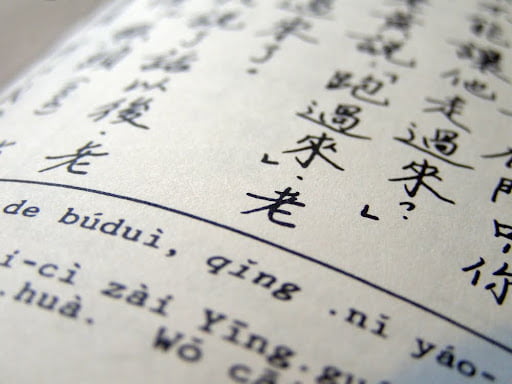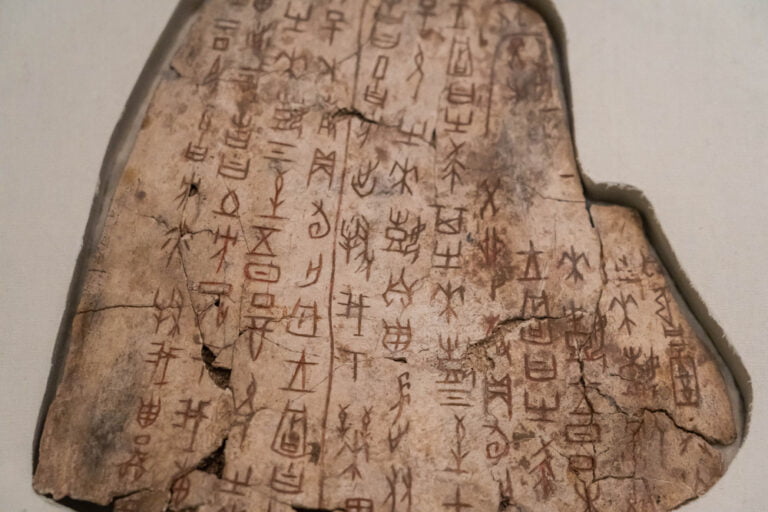Simplified vs Traditional Chinese: Which Should You Learn for Business?

In today’s interconnected world, the ability to communicate effectively in Chinese can be a game-changer for professionals and entrepreneurs looking to expand their horizons in the global marketplace.
If you’re considering learning Chinese for business reasons, you’ll soon come across a crucial decision point: Should you learn Simplified or Traditional Chinese? This choice isn’t about picking between two different languages but two distinct writing systems.
Simplified Chinese and Traditional Chinese are two sides of the same coin, representing the written form of the Chinese language. Whether in Shanghai’s bustling business districts or the historic streets of Taipei, the spoken language bridges people, but the writing system often demands your initial attention.
For those considering learning Chinese for business, understanding this distinction is crucial. The choice between Simplified and Traditional Chinese characters can influence your business strategy, communication, and even relationships in the Chinese-speaking world.
Related Reading: 9 Key Differences between Western and Chinese Business Culture
The evolution of Chinese characters: Simplified and Traditional
The shift of Chinese characters from Traditional to Simplified is a fascinating journey that reflects the dynamic nature of the language and its important role in Chinese culture and society. This transformation didn’t happen overnight but resulted from centuries of gradual changes, culminating in a significant reform in the 20th century aimed at increasing literacy and simplifying the written language.
The roots of Chinese characters

Chinese characters, or Hanzi, are one of the world’s oldest continuously used writing systems. They date back over 3,000 years, with origins traced to oracle bone inscriptions. These characters are logograms, where each symbol represents a word or a morpheme. Over millennia, Chinese characters evolved through several stages, from ancient pictographic and ideographic symbols to the more standardized forms used today.
Traditional Chinese characters
These are the more complex forms of the written language, with many characters containing more strokes. These characters have been used throughout Chinese history and are considered the standard form in places like Taiwan, Hong Kong, and Macau.
Traditional characters are deeply embedded in East Asian culture, embodying historical and aesthetic values. They’re used in classical literature, calligraphy, and in the preservation of Chinese heritage.
The shift to Simplified Chinese
The development of Simplified Chinese characters was part of a broader effort to increase literacy rates and modernize China. The simplification process began in earnest in the 1950s under the People’s Republic of China. The government introduced simplified characters that reduced the number of strokes in many traditional characters.
This was done with the belief that simpler characters would be easier to learn and write, thereby speeding up the learning process and encouraging wider literacy among the Chinese population.
Geographical and cultural divisions
The use of Simplified vs Traditional Chinese characters has created a geographical and cultural division within the Chinese-speaking world. Mainland China and Singapore predominantly use simplified characters, while traditional characters are used in cities like Hong Kong and Macau. This division extends to the diaspora and influences the script choice in overseas Chinese communities.
Impact on learning and business
For learners of Chinese, especially those focusing on learning Chinese for business purposes, understanding the evolution and regional use of these scripts is crucial. The choice between learning simplified or traditional characters often depends on your goals, target market, and personal interests in Chinese culture.
Business professionals must consider their audience and the primary region of their business activities when choosing which script to learn.
This understanding of the evolution of Chinese characters isn’t just academic. Learners and professionals can make informed decisions that align with their objectives in the Chinese-speaking world by appreciating the roots and reasons behind the existence of Simplified and Traditional Chinese.
Related Reading: An Insider’s Guide to Navigating Chinese Business Dinners
Understanding Simplified and Traditional Chinese

Traditional Chinese characters are often celebrated for their aesthetic beauty and historical depth. They’re used in calligraphy, literary works, and cultural ceremonies, embodying centuries of Chinese history and philosophical thought.
Simplified Chinese, while practical for modern uses, carries the spirit of efficiency and modernization that has characterized China’s development in recent decades.
Implications for learning and business
Choosing between Simplified and Traditional Chinese should be a strategic decision influenced by several factors:
- Target market: If your business is focused on mainland China or Singapore, Simplified Chinese is the practical choice. Traditional Chinese will be more appropriate for activities in Taiwan, Macau, or Hong Kong.
- Learning objectives: For learners, the choice may also depend on personal interests or professional needs. Those fascinated by classical literature or calligraphy may lean towards Traditional Chinese, while those seeking efficiency or planning to work in mainland China might prefer Simplified Chinese.
- Business communication: Understanding the preferred script of your target audience is vital. Documents, marketing materials, and digital content should be tailored to the script your clients or partners use to ensure effective communication.
So, the choice between learning Simplified or Traditional Chinese isn’t a linguistic preference but a strategic decision that can have significant implications for business success and cultural understanding.
Whether you opt for Simplified or Traditional Chinese, your efforts to learn this fascinating language will open doors to new opportunities and deepen your appreciation for one of the world’s oldest continuous cultures.
Related Reading: Expert Tips for a Chinese Job Interview
The business landscape in China
If you want to explore the business landscape in China, then you need an understanding of its economic environment, cultural nuances, and the role of language in forging successful business relationships.
As the world’s second-largest economy, China presents vast opportunities and unique challenges for international business professionals. Understanding these dynamics is crucial for anyone looking to conduct business in China.
Key industries
Several sectors stand out in China’s economic landscape, including manufacturing, technology, e-commerce, and services. The country is a global manufacturing hub known for its electronics, textiles, and automotive industries.
In recent years, technology and e-commerce have seen explosive growth, with Chinese companies becoming major players on the world stage. The services sector, including finance, healthcare, and education, has also expanded, reflecting the country’s increasing domestic consumption and middle-class growth.
Cultural and linguistic considerations
Conducting business in China means understanding its economic policies and market trends, but cultural understanding and linguistic competence are equally important. Chinese business culture highly values relationships (关系 – guānxi), trust, and respect. Building strong personal relationships with Chinese partners and clients is often a prerequisite for successful business dealings.
Regional variations
China’s vast geography means that business practices and economic priorities can vary significantly from one region to another. For instance, the eastern coastal regions, including cities like Shanghai and Shenzhen, are known for their openness to international business and advanced technological infrastructure.
In contrast, the central and western regions may offer untapped opportunities but can also pose challenges due to differences in local regulations, market maturity, and consumer behavior.
Related Reading: Can You Learn Chinese While You Sleep?
Simplified Chinese in the business world

In global business, Simplified Chinese has emerged as an excellent asset for professionals and corporations aiming to tap into China’s vast market. The adoption of Simplified Chinese characters reflects a linguistic choice and a strategic business decision, given the economic significance of these regions.
The dominance of Simplified Chinese
Simplified Chinese characters were introduced in the 1950s to promote literacy across China, leading to widespread adoption in education, official communication, and business dealings. This script has become synonymous with the modern Chinese economy, facilitating access to a market encompassing over a billion consumers and countless enterprises.
Simplified Chinese in international business
For international businesses, proficiency in Simplified Chinese offers several advantages:
- Market access: Knowledge of Simplified Chinese opens doors to mainland China’s huge market. It enables businesses to engage directly with consumers, understand local market dynamics, and tackle the regulatory environment more effectively.
- Cultural insight: Learning Simplified Chinese isn’t about language proficiency as such, but more about gaining insights into Chinese culture and business etiquette, which are crucial for building strong relationships and conducting successful negotiations.
- Digital engagement: With China’s digital economy being one of the most advanced globally, Simplified Chinese online is an obvious must-have for digital marketing, e-commerce, and social media engagement, connecting businesses with millions of potential customers.
Simplified Chinese for business professionals
For professionals, learning Simplified Chinese can significantly enhance career prospects. It positions you as a valuable asset to companies looking to expand or strengthen their presence in China. Skills in Simplified Chinese enable direct communication with partners and clients, an understanding of legal and financial documents, and the ability to follow and analyze local business news and trends.
Localization and branding
Using Simplified Chinese in branding and marketing materials demonstrates respect and commitment to the Chinese market. It allows companies to tailor their messages, ensuring cultural relevance and resonance with the local audience. This localization extends far beyond mere translation, encompassing an understanding of nuances, preferences, and consumer behavior in China.
Challenges and considerations
While the focus on Simplified Chinese is strategic, businesses must also be mindful of regional differences within China and the diaspora. Tailoring content and communication strategies to specific audiences, considering local dialects and cultural nuances, remains essential.
As China continues to play a central role in the global economy, the importance of Simplified Chinese for business reasons cannot be overstated. From allowing smoother market entry and expansion to enhancing cultural competence and competitive advantage, Simplified Chinese is a key tool for international businesses and professionals aiming to succeed in the Chinese-speaking world.
This means that investing in learning and utilizing Simplified Chinese isn’t just a linguistic choice but a high-value business decision that can open up numerous opportunities in the dynamic and growing Chinese market.
Related Reading: The True Cost of Fluent Chinese (Way Less than You Think)
Traditional Chinese: When is it essential?

Traditional Chinese characters aren’t merely a writing system but a reflection of history and culture. Understanding when and why Traditional Chinese is crucial can significantly impact your business strategy, cultural appreciation, and communication effectiveness, especially in regions where these characters are prevalent.
Cultural and historical significance
Traditional Chinese characters carry centuries of literary and philosophical heritage. They’re used in cultural and religious texts, classical literature, and historical documents. For businesses dealing with cultural products and historical content or targeting audiences that value traditional heritage, using Traditional Chinese can enhance authenticity and resonance with the target market.
Regional use
Traditional Chinese is the official script in Taiwan, Hong Kong, and Macau. For businesses operating in or targeting these markets, proficiency in Traditional Chinese is essential, showing respect and understanding of local culture and norms.
Whether it’s legal documents, marketing materials, or customer service, employing Traditional Chinese demonstrates commitment and respect to the local business environment and consumer preferences.
The publishing and media industry
Traditional Chinese holds significant importance in the publishing, media, and education sectors. These sectors cater to a diverse audience that often prefers content in Traditional Chinese due to its cultural legacy. Traditional Chinese is the preferred script for authors, publishers, and content creators looking to engage with readers in Taiwan, Hong Kong, and certain overseas Chinese communities.
Cultural products and services
Businesses involved in the arts, calligraphy, traditional medicine, and cultural education will find Traditional Chinese indispensable. These fields are steeped in history and tradition, where the use of Simplified Chinese might convey a different depth and authenticity. In this context, Traditional Chinese isn’t just a means of communication but an integral part of the product or service on offer.
Overseas Chinese communities
The choice between Simplified and Traditional Chinese extends beyond China. Overseas Chinese communities worldwide may prefer one script over the other, often influenced by their regional heritage and the historical period of their migration. Understanding the demographics and preferences of these communities is vital for businesses aiming to engage with the global Chinese diaspora effectively.
Related Reading: Does Reading Help You Speak Chinese?
Simplified or Traditional Chinese: Factors to consider
Choosing between Simplified and Traditional Chinese is a decision that goes beyond mere preference, touching on strategic considerations for businesses and learners alike. Here are the key factors to consider when deciding which script to learn or use in your communications, especially regarding Chinese for business.
1. Target market and region
The most critical factor is your target audience and their location. Simplified Chinese is predominantly used in mainland China and Singapore, making it ideal for businesses targeting these markets. On the other hand, Traditional Chinese is the script of choice in places like Hong Kong and Macau. Understanding the geographical preferences of your audience ensures effective communication and demonstrates cultural sensitivity.
2. Industry and sector specifics
Some industries may have a stronger preference or tradition of using one script over the other. For instance, sectors related to cultural heritage, traditional arts, and specific academic fields might lean towards Traditional Chinese due to its historical and cultural depth. Meanwhile, Simplified Chinese might be more prevalent in sectors aiming for mass outreach in mainland China, such as consumer goods, technology, and e-commerce.
3. Business goals and objectives
Your long-term business strategy should inform your choice between learning Simplified and Traditional Chinese. If expansion into mainland Chinese markets is a goal, Simplified Chinese would be a practical choice.
However, learning and using Traditional Chinese would be beneficial if your business aims to establish a presence in markets that use Traditional Chinese or wants to appeal to a diaspora that prefers Traditional script.
4. Cultural and linguistic authenticity
The choice of script can also reflect cultural respect and authenticity. Traditional Chinese may be more appropriate for products or services emphasizing cultural heritage, artisanal craftsmanship, or historical accuracy. In contrast, Simplified Chinese aligns with modernity and efficiency, resonating with contemporary audiences in mainland China.
5. Digital presence and online engagement
Your digital strategy should also influence your script choice. Simplified Chinese is essential for engaging with mainland China’s vast internet user base, where digital platforms, social media, and e-commerce play significant roles.
On the other hand, Traditional Chinese is crucial for platforms and audiences in Taiwan and Hong Kong, where it can enhance local engagement and brand perception.
Deciding whether to focus on Simplified or Traditional Chinese involves weighing various considerations. By carefully evaluating these factors, businesses and learners can make informed decisions that align with their goals, ensuring effective communication and meaningful engagement with Chinese-speaking audiences.
Related Reading: Mastering WeChat: How to Use China’s Biggest Social Media for Business
Unlock your path to Mandarin mastery
The choice between Simplified and Traditional Chinese is more than a preference — it’s a strategic decision that aligns with your professional aspirations and market focus. Whether you aim to navigate the bustling business hubs of mainland China or connect with the rich cultural landscapes of Taiwan or Hong Kong, mastering Mandarin offers unparalleled advantages.
But how do you move from aspiration to action, especially when the path to fluency seems so daunting? The answer lies in understanding your current level and the specific steps you need to take to improve.
That’s where our FREE Mandarin Fluency Scorecard comes into play. Designed to offer you a personalized assessment of your Chinese skills, this tool is your first step toward achieving language mastery.
By completing the Mandarin Fluency Scorecard, you’ll gain valuable insights into your weaknesses and the barriers standing between you and fluency. More importantly, you’ll discover what your next steps should be, tailored to your current level.
Whether you’re grappling with basic vocabulary or fine-tuning your business negotiation phrases, our custom report will provide immediate action steps.
Start your journey equipped with a clear plan. It’s free, effortless, and takes under 60 seconds. Don’t let uncertainty hold you back. Identify, discover, and act on your Mandarin learning journey today.
Complete your Mandarin Fluency Scorecard and unlock the door to fluency. Your customized guide to mastering Chinese for business awaits.








